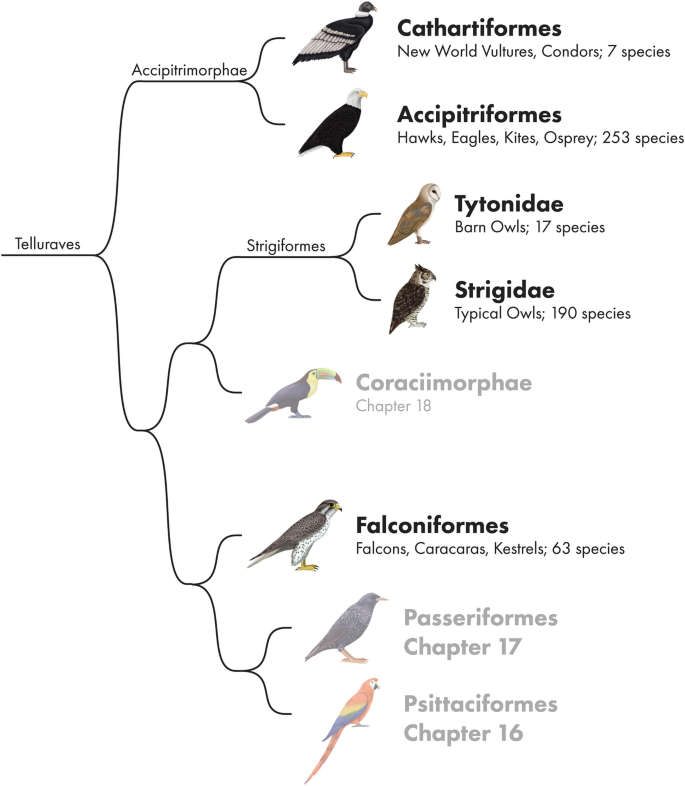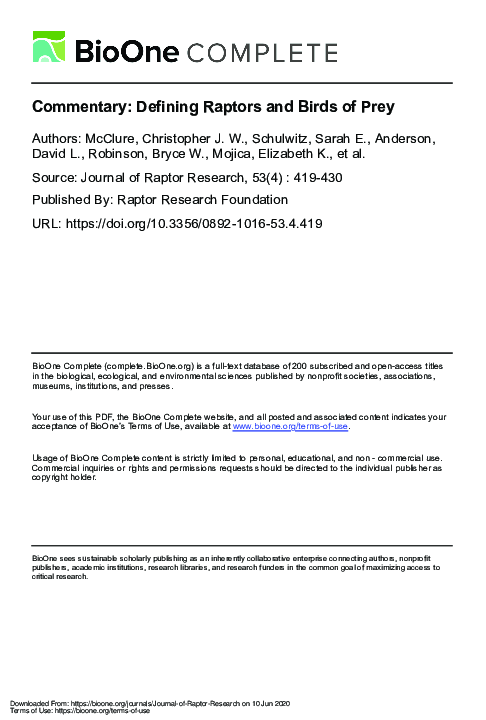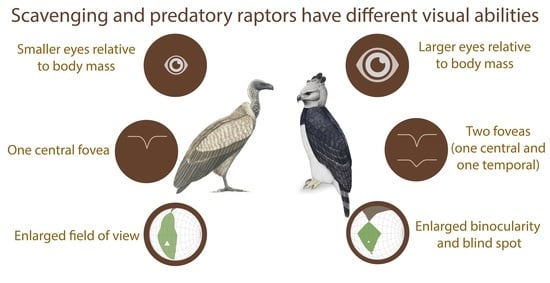Commentary: Defining Raptors and Birds of Prey
Por um escritor misterioso
Last updated 23 dezembro 2024

Species considered raptors are subjects of monitoring programs, textbooks, scientific societies, legislation, and multinational agreements. Yet no standard definition for the synonymous terms “raptor” or “bird of prey” exists. Groups, including owls, vultures, corvids, and shrikes are variably considered raptors based on morphological, ecological, and taxonomic criteria, depending on the authors. We review various criteria previously used to define raptors and we present an updated definition that incorporates current understanding of bird phylogeny. For example, hunting live vertebrates has been largely accepted as an ecological trait of raptorial birds, yet not all species considered raptors are raptorial (e.g., Palm-nut Vulture [Gypohierax angolensis]), and not all raptorial birds are considered raptors (e.g., skuas [Stercorariidae]). Acute vision, a hooked bill, and sharp talons are the most commonly used morphological characters for delineating raptors; however, using those characters as criteria may cause confusion because they can be vague and exceptions are sometimes made. Old World vultures, for example, are in the family Accipitridae along with hawks and eagles, and thus are usually considered raptors despite their lack of sharp talons. We define raptors as species within orders that evolved from raptorial landbirds (Telluraves) in which most species maintained raptorial lifestyles. Raptors are therefore all species within Accipitriformes, Cathartiformes, Falconiformes, and Strigiformes. Importantly, we believe that seriemas (Cariamiformes) should also be considered raptors. Our definition combines phylogeny with morphology and ecology, and avoids ambiguity associated with owls, vultures, and shrikes. Establishing a common definition of raptors should improve interpretability across studies and lessen ambiguity of research and management recommendations.

raptor

Ophthalmology of Accipitrimorphae, Strigidae, and Falconidae: Hawks, Eagles, Vultures, Owls, Falcons, and Relatives

Is There a Difference Between a Raptor and a Bird of Prey? – Owl Brand Discovery Kits

Visual adaptations of diurnal and nocturnal raptors - ScienceDirect

PDF) Commentary: Defining Raptors and Birds of Prey

Who we are - RAPTORS RIDGE BIRDS OF PREY INC
Description Raptors are formally classified into five families and include birds-such as eagles, ospreys, kites, true hawks, buzzards, harriers,

Raptors: The Curious Nature of Diurnal Birds of Prey

Vulture Research Update: November 2019 - June 2020 - Vulture Conservation Foundation

Diversity, Free Full-Text
Recomendado para você
-
 Birds of Prey - Definition & List of Names With Pictures23 dezembro 2024
Birds of Prey - Definition & List of Names With Pictures23 dezembro 2024 -
 bird of prey - Kids, Britannica Kids23 dezembro 2024
bird of prey - Kids, Britannica Kids23 dezembro 2024 -
 Peregrine Falcon The Nature Conservancy23 dezembro 2024
Peregrine Falcon The Nature Conservancy23 dezembro 2024 -
 bird-of-prey noun - Definition, pictures, pronunciation and usage notes Oxford Advanced Learner's Dictionary at23 dezembro 2024
bird-of-prey noun - Definition, pictures, pronunciation and usage notes Oxford Advanced Learner's Dictionary at23 dezembro 2024 -
 Birds of Prey – Cape Cod 5 Educational Mini-Grants23 dezembro 2024
Birds of Prey – Cape Cod 5 Educational Mini-Grants23 dezembro 2024 -
 Birds of Prey Animal Story23 dezembro 2024
Birds of Prey Animal Story23 dezembro 2024 -
 Hawks ~ These birds of prey have long been sacred to cultures all over the world. Hawks…23 dezembro 2024
Hawks ~ These birds of prey have long been sacred to cultures all over the world. Hawks…23 dezembro 2024 -
 Circus cyaneus, Print, The hen harrier (Circus cyaneus) is a bird of prey. The genus name Circus is derived from Ancient Greek kirkos, meaning 'circle', referring to a bird of prey named23 dezembro 2024
Circus cyaneus, Print, The hen harrier (Circus cyaneus) is a bird of prey. The genus name Circus is derived from Ancient Greek kirkos, meaning 'circle', referring to a bird of prey named23 dezembro 2024 -
 Birds of prey facts and conservation status23 dezembro 2024
Birds of prey facts and conservation status23 dezembro 2024 -
 Birds of Prey (Visual Explorers Series)23 dezembro 2024
Birds of Prey (Visual Explorers Series)23 dezembro 2024
você pode gostar
-
🔥CHEAPEST🔥FIFA 23: STANDARD EDITION PC Game EA Origin [Can play Online/Offline], Video Gaming, Video Games, Others on Carousell23 dezembro 2024
-
 Johnny Depp está namorando advogada que o defendeu em processo - Roberta Jungmann23 dezembro 2024
Johnny Depp está namorando advogada que o defendeu em processo - Roberta Jungmann23 dezembro 2024 -
 RhinoShield X One Piece SolidSuit iPhone 12 Pro Case - Zoro – RHINOSHIELD Europe23 dezembro 2024
RhinoShield X One Piece SolidSuit iPhone 12 Pro Case - Zoro – RHINOSHIELD Europe23 dezembro 2024 -
 Pin on การบันทึกอย่างรวดเร็ว23 dezembro 2024
Pin on การบันทึกอย่างรวดเร็ว23 dezembro 2024 -
 Chainsaw Man Episode 4 - Anime Review - DoubleSama23 dezembro 2024
Chainsaw Man Episode 4 - Anime Review - DoubleSama23 dezembro 2024 -
 Armored Mewtwo - Pokemon Sun & Moon Promos - Pokemon23 dezembro 2024
Armored Mewtwo - Pokemon Sun & Moon Promos - Pokemon23 dezembro 2024 -
 Get All Battlefield 4 Expansion Packs for Free Until September 1923 dezembro 2024
Get All Battlefield 4 Expansion Packs for Free Until September 1923 dezembro 2024 -
 Noa Lang Evolutions II EA FC 24 - 79 - Rating and Price23 dezembro 2024
Noa Lang Evolutions II EA FC 24 - 79 - Rating and Price23 dezembro 2024 -
 Sinopsis Kuro No Shoukanshi (Black Summoner), Anime Isekai Overpower Terbaru - Duniamasa23 dezembro 2024
Sinopsis Kuro No Shoukanshi (Black Summoner), Anime Isekai Overpower Terbaru - Duniamasa23 dezembro 2024 -
 File:Spartak Moscow fans.jpg - Wikimedia Commons23 dezembro 2024
File:Spartak Moscow fans.jpg - Wikimedia Commons23 dezembro 2024
![🔥CHEAPEST🔥FIFA 23: STANDARD EDITION PC Game EA Origin [Can play Online/Offline], Video Gaming, Video Games, Others on Carousell](https://media.karousell.com/media/photos/products/2023/8/3/cheapestfifa_23_standard_editi_1691054813_f3cabf7d_progressive)